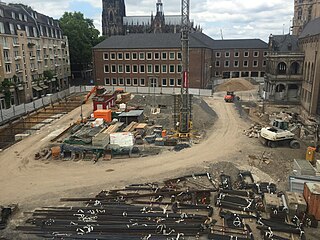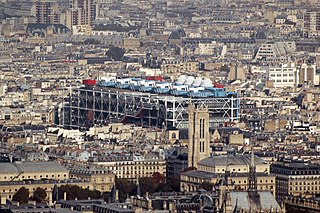Related Research Articles
Project management is the process of leading the work of a team to achieve all project goals within the given constraints. This information is usually described in project documentation, created at the beginning of the development process. The primary constraints are scope, time, and budget. The secondary challenge is to optimize the allocation of necessary inputs and apply them to meet pre-defined objectives.

Construction is a general term meaning the art and science to form objects, systems, or organizations, and comes from Latin constructio and Old French construction. To construct is the verb: the act of building, and the noun is construction: how something is built, the nature of its structure.
A project manager is a professional in the field of project management. Project managers have the responsibility of the planning, procurement and execution of a project, in any undertaking that has a defined scope, defined start and a defined finish; regardless of industry. Project managers are first point of contact for any issues or discrepancies arising from within the heads of various departments in an organization before the problem escalates to higher authorities, as project representative.

IDEF, initially an abbreviation of ICAM Definition and renamed in 1999 as Integration Definition, is a family of modeling languages in the field of systems and software engineering. They cover a wide range of uses from functional modeling to data, simulation, object-oriented analysis and design, and knowledge acquisition. These definition languages were developed under funding from U.S. Air Force and, although still most commonly used by them and other military and United States Department of Defense (DoD) agencies, are in the public domain.

In industry, product lifecycle management (PLM) is the process of managing the entire lifecycle of a product from its inception through the engineering, design and manufacture, as well as the service and disposal of manufactured products. PLM integrates people, data, processes, and business systems and provides a product information backbone for companies and their extended enterprises.
Web development is the work involved in developing a website for the Internet or an intranet. Web development can range from developing a simple single static page of plain text to complex web applications, electronic businesses, and social network services. A more comprehensive list of tasks to which Web development commonly refers, may include Web engineering, Web design, Web content development, client liaison, client-side/server-side scripting, Web server and network security configuration, and e-commerce development.
Design–build, also known as alternative delivery, is a project delivery system used in the construction industry. It is a method to deliver a project in which the design and construction services are contracted by a single entity known as the design–builder or design–build contractor. It can be subdivided into architect-led design–build and contractor-led design–build.
Target costing is an approach to determine a product's life-cycle cost which should be sufficient to develop specified functionality and quality, while ensuring its desired profit. It involves setting a target cost by subtracting a desired profit margin from a competitive market price. A target cost is the maximum amount of cost that can be incurred on a product, however, the firm can still earn the required profit margin from that product at a particular selling price. Target costing decomposes the target cost from product level to component level. Through this decomposition, target costing spreads the competitive pressure faced by the company to product's designers and suppliers. Target costing consists of cost planning in the design phase of production as well as cost control throughout the resulting product life cycle. The cardinal rule of target costing is to never exceed the target cost. However, the focus of target costing is not to minimize costs, but to achieve a desired level of cost reduction determined by the target costing process.
Construction management (CM) aims to control the quality of a project's scope, time, and cost to maximize the project owner's satisfaction. It uses project management techniques and software to oversee the planning, design, construction and closeout of a construction safely, on time, on budget and within specifications.

Organizational architecture, also known as organizational design, is a field concerned with the creation of roles, processes, and formal reporting relationships in an organization. It refers to architecture metaphorically, as a structure which fleshes out the organizations. The various features of a business's organizational architecture has to be internally consistent in strategy, architecture and competitive environment.
The incremental build model is a method of software development where the product is designed, implemented and tested incrementally until the product is finished. It involves both development and maintenance. The product is defined as finished when it satisfies all of its requirements. This model combines the elements of the waterfall model with the iterative philosophy of prototyping. According to the Project Management Institute, an incremental approach is an "adaptive development approach in which the deliverable is produced successively, adding functionality until the deliverable contains the necessary and sufficient capability to be considered complete."

Design management is a field of inquiry that uses design, strategy, project management and supply chain techniques to control a creative process, support a culture of creativity, and build a structure and organization for design. The objective of design management is to develop and maintain an efficient business environment in which an organization can achieve its strategic and mission goals through design. Design management is a comprehensive activity at all levels of business, from the discovery phase to the execution phase. "Simply put, design management is the business side of design. Design management encompasses the ongoing processes, business decisions, and strategies that enable innovation and create effectively-designed products, services, communications, environments, and brands that enhance our quality of life and provide organizational success." The discipline of design management overlaps with marketing management, operations management, and strategic management.
The engineering design process, also known as the engineering method, is a common series of steps that engineers use in creating functional products and processes. The process is highly iterative – parts of the process often need to be repeated many times before another can be entered – though the part(s) that get iterated and the number of such cycles in any given project may vary.
Lean construction is a combination of operational research and practical development in design and construction with an adoption of lean manufacturing principles and practices to the end-to-end design and construction process. Unlike manufacturing, construction is a project-based production process. Lean Construction is concerned with the alignment and holistic pursuit of concurrent and continuous improvements in all dimensions of the built and natural environment: design, construction, activation, maintenance, salvaging, and recycling. This approach tries to manage and improve construction processes with minimum cost and maximum value by considering customer needs.
Front-end loading (FEL), also referred to as pre-project planning (PPP), feasibility analysis, conceptual planning, programming/schematic design and early project planning, is the process for conceptual development of projects in processing industries such as upstream oil and gas, petrochemical, natural gas refining, extractive metallurgy, waste-to-energy, and pharmaceuticals. This involves developing sufficient strategic information with which owners can address risk and make decisions to commit resources in order to maximize the potential for success.
A glossary of terms relating to project management and consulting.
Performance-Based Building Design is an approach to the design of any complexity of building, from single-detached homes up to and including high-rise apartments and office buildings. A building constructed in this way is required to meet certain measurable or predictable performance requirements, such as energy efficiency or seismic load, without a specific prescribed method by which to attain those requirements. This is in contrast to traditional prescribed building codes, which mandate specific construction practises, such as stud size and distance between studs in wooden frame construction. Such an approach provides the freedom to develop tools and methods to evaluate the entire life cycle of the building process, from the business dealings, to procurement, through construction and the evaluation of results.
Fast-track building construction is construction industry jargon for a project delivery strategy to start construction before the design is complete. The purpose is to shorten the time to completion.
The following outline is provided as an overview of and topical guide to project management:

Architectural technology, or building technology, is the application of technology to the design of buildings. It is a component of architecture and building engineering and is sometimes viewed as a distinct discipline or sub-category. New materials and technologies generated new design challenges and construction methods throughout the evolution of building, especially since the advent of industrialisation in the 19th century. Architectural technology is related to the different elements of a building and their interactions; it is closely aligned with advances in building science.
References
- ↑ The Institution of Professional Engineers New Zealand Incorporated (IPENZ). Constructability. Archived 2011-10-18 at the Wayback Machine Practice Note 13. April, 2008.
- ↑ Construction Industry Institute (1986). Constructability: A Primer. Research Summary 3-1.
- ↑ Schwinger, Clifford W. (March 2011). "Tips for Designing Constructable Steel-Framed Buildings" (PDF). Modern Steel Construction. Retrieved April 30, 2019.
- ↑ Gambatese, John A.; Hinze, Jimmie; Behm, Michael (May 2005). "Investigation of the Viability of Designing for Safety" (PDF). CPWR - The Center to Protect Workers' Rights. p. 5. Retrieved April 30, 2019.
- ↑ Construction Industry Research and Information Association
- ↑ McGeorge, Palmer & Kerry London. Construction management: new directions, 2nd ed. Blackwell Science, 2002, p. 54.
- ↑ Construction Industry Institute (CII), based at The University of Texas at Austin. CII Best Practices: Constructability
- ↑ Construction Industry Institute, Australia.
- 1 2 Singh, Amarjit (2001). Creative Systems in Structural and Construction Engineering. Balkema. pp. 96, 97. ISBN 9058091619.